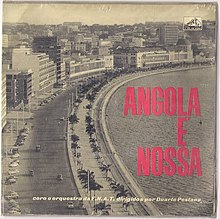Draft:Angola é Nossa
(this is a temporary note that should be removed if this gets out of the draftspace: this is an incomplete machine translation of the original portuguese version of the article, any help in translation by any native or second language portuguese speakers would be greatly appreciated!)
| "Angola é Nossa!" | |
|---|---|
 Angola é Nossa cover | |
| Song by the Choir and Orchestra from FNAT | |
| Language | Portuguese |
| Genre | Portuguese Patriotic Song |
| Label | Victor Records |
| Composer(s) | Santos Braga |
| Lyricist(s) | Duarte F. Pestana |
| Producer(s) | Victor Records |
"Angola é Nossa" is a song with lyrics by Santos Braga and music by Duarte F. Pestana, released in June 1961. It is a notable piece of propaganda. A heroic and triumphalist anthem, which immediately became a kind of Angolan anthem, which closed and opened radio broadcasts and was sung in schools[1] during the Portuguese colonial administration.
History[edit]
When in March 1961 there were the first attacks by the Angolan liberation armies and the first massacres, the Portuguese government responded by sending more troops, more military attacks and other types of written and spoken propaganda. in Angola 33 thousand and 500 Portuguese soldiers. No one needed to doubt that Angola was part of Portugal.[2]
Thus was born, in June 1961, the anthem “Angola é Nossa”, with music by Duarte Pestana and lyrics by Santos Braga, performed by the choir and orchestra of FNAT – National Federation for Joy in Work.[3]

“Angola é Nossa” was, so to speak, one of the best means of sound dissemination to show the world that the Colonial War had no basis, since Angola was Portuguese territory. Although composed with the required brevity (with music by Duarte Pestana and lyrics by Santos Braga), the theme gained popularity, as if it were a new Anthem of Angola. Merit also goes to the excellent interpretation of the F.N.A.T Choir and Orchestra. (National Federation for Joy at Work).[4]
In 1975, and, against the best predictions, “Angola é Nossa” was once again spoken of for other reasons (controversial again), due to Vilhena’s drawings and sayings. As always scathing and sharp, Vilhena ridiculed in his “Open Gaiola” the disastrous policy of Portuguese decolonization in Angola by one of the main mentors, General Melo Antunes. On the central pages, (usual poster designed by the author), the general appears with a baton in his hands humming “Angola is Ours! Angola is Ours!” to the various leaders of African movements, as if it were a choir of good boys.
This is a remarkable piece of propaganda. A heroic and triumphalist anthem, which immediately became a kind of Angolan anthem, which closed and opened radio broadcasts and was sung in schools.[3]
References[edit]
- ^ ""Angola é Nossa" - Canções da Guerra"Angola é Nossa" - Canções da Guerra | RTP". Canções da Guerra (in European Portuguese). 2015-09-11. Retrieved 2020-01-26.
- ^ ""Angola é Nossa" - Canções da Guerra"Angola é Nossa" - Canções da Guerra | RTP". Canções da Guerra (in European Portuguese). 2015-09-11. Retrieved 2020-01-26.
- ^ a b ""Angola é Nossa" - Canções da Guerra"Angola é Nossa" - Canções da Guerra | RTP". Canções da Guerra (in European Portuguese). 2015-09-11. Retrieved 2020-01-26.
- ^ "O Covil do Vinil". ocovildovinil.pt (in Portuguese). Retrieved 2020-01-26.
